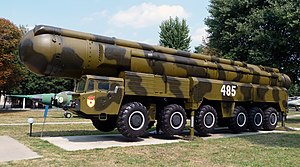
Back RSD-10 Pioner Azerbaijani РТ-21М Bulgarian RSD-10 Czech RT-21M Danish RSD-10 German RSD-10 Spanish RT-21M Pioneer Finnish RSD-10 Pionnier French RSD-10 Galician SS-20 Saber HE
| RSD-10 Pioneer SS-20 Saber | |
|---|---|
 RT-21M Pioneer missile and launcher on display in Vinnytsia | |
| Type | Intermediate-range ballistic missile |
| Place of origin | Soviet Union |
| Service history | |
| In service | 1976 – 1988 |
| Used by | Soviet Strategic Rocket Forces |
| Production history | |
| Designer | Alexander Nadiradze (Moscow Institute of Thermal Technology) |
| Manufacturer | Votkinsk Machine Building Plant |
| Specifications | |
| Mass | 51,900 kg (114,400 lb) |
| Length | 21.5 m (71 ft) |
| Diameter | 2.18 m (7 ft 2 in) |
| Warhead | 1 x 1 Mt or 3 x 150 kt |
| Engine | Two-stage solid-fuel rocket[1] |
Operational range | 5,800 km (3,600 mi) |
| Maximum speed | Up to 7.43 km/s |
Guidance system | Inertial |
| Accuracy | 150-450 m CEP |
Launch platform | Road-mobile TEL |
The RSD-10 Pioneer (Russian: ракета средней дальности (РСД) «Пионер» tr.: raketa sredney dalnosti (RSD) "Pioner"; English: Medium-Range Missile "Pioneer") was an intermediate-range ballistic missile with a nuclear warhead, deployed by the Soviet Union from 1976 to 1988. It carried GRAU designation 15Ж45 (15Zh45). Its NATO reporting name was SS-20 Saber.
Its deployment was a major cause of NATO's 'Double-Track Decision', which led to the deployment of more medium-range nuclear weapons in Western Europe. The RSD-10 was withdrawn from service under the 1987 Intermediate-Range Nuclear Forces Treaty.
© MMXXIII Rich X Search. We shall prevail. All rights reserved. Rich X Search